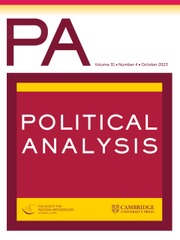Article contents
Estimating Voter Registration Deadline Effects with Web Search Data
Published online by Cambridge University Press: 04 January 2017
Abstract
Electoral rules have the potential to affect the size and composition of the voting public. Yet scholars disagree over whether requiring voters to register well in advance of Election Day reduces turnout. We present a new approach, using web searches for “voter registration” to measure interest in registering, both before and after registration deadlines for the 2012 U.S. presidential election. Many Americans sought information on “voter registration” even after the deadline in their state had passed. Combining web search data with evidence on the timing of registration for 80 million Americans, we model the relationship between search and registration. Extrapolating this relationship to the post-deadline period, we estimate that an additional 3–4 million Americans would have registered in time to vote, if deadlines had been extended to Election Day. We test our approach by predicting out of sample and with historical data. Web search data provide new opportunities to measure and study information-seeking behavior.
Information
- Type
- Articles
- Information
- Creative Commons
- This is an Open-Access article, distributed under the terms of the Creative Commons Attribution license (http://creativecommons.org/licenses/by/4.0/), which permits unrestricted re-use, distribution, and reproduction in any medium, provided the original work is properly cited.
- Copyright
- Copyright © The Author 2015. Published by Oxford University Press on behalf of the Society for Political Methodology
Footnotes
Authors' note: The authors thank Mike Alvarez and two anonymous reviewers for valuable comments, and Joshua Dyck, Peter Enns, Matt Filner, Alex Kuo, Renee Liu, Philipp Rehm, Steve Scott, Daniel Smith, Nigel Snoad, Seth Stephens-Davidowitz, Hal Varian and seminar participants at Cornell University and Google for helpful suggestions. Replication data are available in Street et al. (2015). Supplementary materials for this article are available on the Political Analysis web site.
References
- 18
- Cited by

